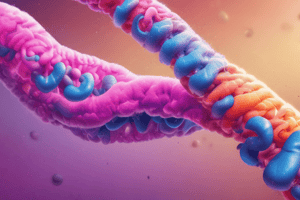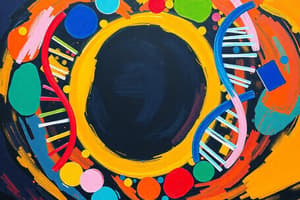Podcast
Questions and Answers
If a cell loses a chromosome, what is the most likely outcome, and why?
If a cell loses a chromosome, what is the most likely outcome, and why?
- The cell will experience a minor reduction in function but will otherwise remain viable.
- The loss is usually a lethal event because chromosomes contain information for multiple processes and structures. (correct)
- The cell will continue to function normally, as other chromosomes can compensate for the missing information.
- The cell will divide uncontrollably, leading to rapid growth and tumor formation.
In the context of the 'cookbook' analogy, what does accessing multiple 'cookbooks' (chromosomes) to make a mitochondria imply about cellular processes?
In the context of the 'cookbook' analogy, what does accessing multiple 'cookbooks' (chromosomes) to make a mitochondria imply about cellular processes?
- Mitochondria are created through a simple, self-contained process that requires minimal genetic information.
- The information required to construct a cellular component is scattered across multiple chromosomes. (correct)
- The cell randomly selects information from different chromosomes to assemble cellular components.
- Each cellular component, like a mitochondria, is encoded by a single, dedicated chromosome.
How many chromosomes do human gametes possess?
How many chromosomes do human gametes possess?
- Varies Significantly
- 92
- 23 (correct)
- 46
Which of the following best describes the organization of genetic information within chromosomes?
Which of the following best describes the organization of genetic information within chromosomes?
If a scientist is studying the entire DNA content of a cell, what term would they use to refer to this?
If a scientist is studying the entire DNA content of a cell, what term would they use to refer to this?
How does the organization of information within chromosomes contribute to the potential lethality of chromosome loss?
How does the organization of information within chromosomes contribute to the potential lethality of chromosome loss?
Which of the following is NOT a key characteristic of chromosomes?
Which of the following is NOT a key characteristic of chromosomes?
Eukaryotic cells ensure genetic stability through multiple mechanisms. Which scenario would MOST likely lead to a lethal outcome for the cell?
Eukaryotic cells ensure genetic stability through multiple mechanisms. Which scenario would MOST likely lead to a lethal outcome for the cell?
If a newly discovered species has a diploid number of 60, what is its haploid number?
If a newly discovered species has a diploid number of 60, what is its haploid number?
Why is it important for gametes to have a haploid number of chromosomes?
Why is it important for gametes to have a haploid number of chromosomes?
Homologous chromosomes contain the same genes but might have different versions (alleles) of those genes. Which scenario best illustrates the potential outcome of these allelic differences?
Homologous chromosomes contain the same genes but might have different versions (alleles) of those genes. Which scenario best illustrates the potential outcome of these allelic differences?
Which of the following statements explains the relationship between haploid and diploid cells?
Which of the following statements explains the relationship between haploid and diploid cells?
A researcher discovers a new organism that can reproduce both sexually and asexually. Under which condition would the diploid complement be most advantageous for the organism's survival, according to the text?
A researcher discovers a new organism that can reproduce both sexually and asexually. Under which condition would the diploid complement be most advantageous for the organism's survival, according to the text?
Considering the concept of diploidy as having two 'recipe books' (sets of chromosomes), what is the most significant advantage of having this redundancy?
Considering the concept of diploidy as having two 'recipe books' (sets of chromosomes), what is the most significant advantage of having this redundancy?
Which of the following analogies best describes the relationship between homologous chromosomes?
Which of the following analogies best describes the relationship between homologous chromosomes?
Flashcards
Gametes
Gametes
Reproductive cells (sperm and egg) with half the number of chromosomes.
Haploid Number
Haploid Number
The number of chromosomes in a gamete (n). In humans, n = 23.
Homologous Chromosomes
Homologous Chromosomes
Pairs of chromosomes (one from each parent) that carry genes for the same traits.
Diploid
Diploid
Signup and view all the flashcards
Haploid
Haploid
Signup and view all the flashcards
Diploidy
Diploidy
Signup and view all the flashcards
Diploid Complement
Diploid Complement
Signup and view all the flashcards
Genome
Genome
Signup and view all the flashcards
Chromosomes
Chromosomes
Signup and view all the flashcards
Human Chromosome Number
Human Chromosome Number
Signup and view all the flashcards
Importance of Chromosome Integrity
Importance of Chromosome Integrity
Signup and view all the flashcards
Multi-Functionality of Chromosomes
Multi-Functionality of Chromosomes
Signup and view all the flashcards
What are chromosomes?
What are chromosomes?
Signup and view all the flashcards
Cellular Mechanisms
Cellular Mechanisms
Signup and view all the flashcards
Study Notes
- The genome is the complete DNA content within a cell.
- DNA is organized into discrete structures known as chromosomes.
Chromosome Organization
- Chromosomes are analogous to cookbooks, containing various recipes (genes).
- Each chromosome has an assortment of genetic information not restricted to one process or structure.
- Multiple chromosomes are necessary to create a structure like a mitochondria.
- Loss of even one chromosome can be lethal as it disrupts multiple processes.
- Multicellular organisms generally have multiple chromosomes.
Chromosome Number in Humans
- Most human cells contain 46 chromosomes.
- Gametes (egg and sperm cells) are an exception.
- Gametes possess half the number of chromosomes as other cells (23 in humans).
- The number of chromosomes in a gamete is the haploid number, abbreviated as 'n' (in humans n=23).
- The fusion of egg and sperm restores the normal chromosome count (46 in humans).
Homologous Chromosomes
- Egg and sperm each contain 23 unique chromosomes, contributing DNA from both parents.
- Homologous chromosomes are similar but may have different versions of the same information (e.g., freckles vs. no freckles).
- Homologous chromosomes, also known as homologs, are like different versions of the same cookbook.
Diploid Complements
- Diploid organisms have two complete sets of chromosomes.
- Gametes have one set of 23 chromosomes which is called haploid.
- Organisms with two haploid sets are called diploid.
- Diploidy (2n) refers to having twice the number of chromosomes as gametes (46 chromosomes in humans).
- 'Di' is a root word signifying "two," with "ploid" referring to chromosome sets.
- Diploidy may have evolved as a form of backup information.
- A backup chromosome acts as a template to repair damaged DNA.
Studying That Suits You
Use AI to generate personalized quizzes and flashcards to suit your learning preferences.
Description
Explore chromosome organization, analogyzing them to cookbooks containing genes. Understand the significance of chromosome number in human cells, contrasting somatic cells with gametes. Learn about the haploid number and the role of homologous chromosomes in maintaining genetic integrity.




